French Feudalists coins catalog with values
County of Angouleme
denier
Anonymous coinage
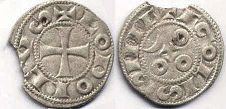
denier no date (12-13 century)
silver
LODOICVS
EGOLISSIME
Value - 35-45 USD
County of Auxonne
The county with its capital in the city of
the same name was located in the territory of Franche-Comté
(between Dijon and Besançon, most of the county stretched to the
south). Formed in 1237, when the Duke of Burgundy, Hugo IV,
acquired these lands from Count Jean I de Chalons, who received
other territories in exchange. By the way, these other lands
turned out to be rich in salt deposits and the count became
fabulously rich. Apparently, it’s not for nothing that he was
called wise :).
In 1477, the county was captured by the army of Louis XI and
annexed to the kingdom.
denier
Philipp III the Good duke of Burgundy (1419-1467)
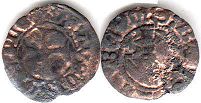
denier (demi-double) no date
billon
D DVPLE DE AVXON
PHS DVX ET COME BV
Value - 50-60 USD
Charles the Bold duke of Burgundy (1467-1477)
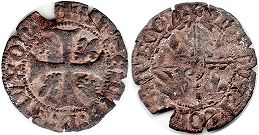
Engrogne (denier) no date
billon
ANSERNA DE AVXONNA
KAROLVS DVX ET COM B
Value - 30-40 USD
Duchy of Boisbelle and Henrichemont
Ecu=24 grosch; Grosch=4 liard; Liard=3 denier
Maximilien de Bethune (1597-1641)
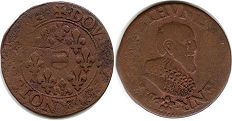
Double tournois (2 denier) 1636
copper
DOVBLE TOVRNOIS 1636
MAXI BET P S DENRIC ET BB
Value - 10-15 USD
Archbishopric of Cambrai
Ecu=24 grosch; Grosch=4 liard; Liard=3 denier
Louis de Berlaymont (1570-1596)
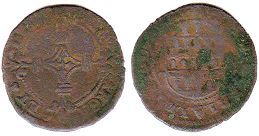
2 denier no date
copper
ARCH ET DVX CAM
LVD A BERLAIMONT D GRA
Value - 40-50 USD
County of Chartres
denier
Anonymous coinage
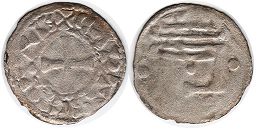
anonymous grand denier no date (XIII century)
silver
CARTIS CIVITAS
Value - 50-60 USD
Principality of Chateau-Regnault
The Principality was essentially a castle in the Ardennes, on the border of the Netherlands, France and the Holy Roman Empire. Naturally, his lords preferred not to depend on either one, or the other, or the third. In 1570, the castle was given to Henry de Guise (“the Marked One”) as a dowry upon marriage, and he organized the minting of coins there. Of the principality’s own coins, only double deniers are known, but the local mint became famous for counterfeiting French banknotes, which brought considerable income to its owners. In 1629, Cardinal Richelieu got tired of this and forced the Marked One’s daughter Louise-Margarita (the owner of the castle and the wife of the nominal prince of Chateau-Renaud, Prince de Conti) to sell the castle to the French crown.
Ecu=24 grosch; Grosch=4 liard; Liard=3 denier
Francois de Bourbon prince de Conti (1603-1605)
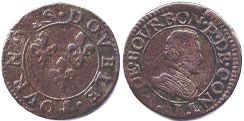
double denier tournois no date
copper
DOVBLE TOVRNOIS
F DE BOVRBON P DE CONTI
Value - 15-20 USD
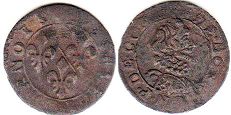
double denier tournois no date
copper
DOVBLE TOVRNOIS
P DE CONTI F DE BOVRBON
Value - 10-15 USD
Bishopric of Clermont
denier
Anonymous coinage
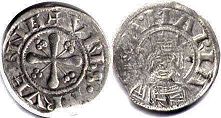
denier no date (13 century)
silver
VRBS ARVERNA
SEA MARIA
Value - 35-45 USD
County of Gien
denier
Geoffrey II (1120-1180)
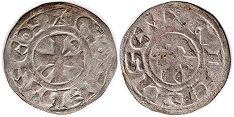
denier no date
silver
COSEDVS COS
GIEMIS CA
Value - 25-35 USD
Bishopric and City of Kahors
denier
Anonymous coinage
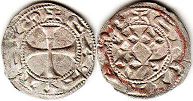
denier no date (XII-XIII century)
silver
CATVRCIS
CIVITAS
Value - 50-70 USD
Archbishopric of Lyon
According to legend, the first bishop of
Lyon was appointed in the middle of the 2nd century.
At the end of the 5th century, the city of Lyon was the center
of a county in the Kingdom of Burgundy, and after 534 it came
under the rule of the kings of France.
In 1157, Holy Roman Emperor Frederick Barbarossa transferred
control of the County of Lyon to the archbishop.
The Thirteenth (1245) and Fourteenth (1274) Ecumenical Church
Councils took place in Lyon.
In 1312, Philip the Fair annexed the city to the Kingdom of
France, but until the early 15th century the Archbishopric of
Lyon was allowed to mint its own coins.
denier
Anonymous coinage
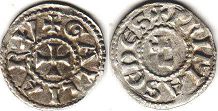
denier no date (XIII-XIV century)
silver
GALLIARV
PRIMA SEDES / L
Value - 25-35 USD

obole (half denier) no date (XIII-XIV century)
billon
GALLIARV
PRIMA SEDES / L
Value - 45-55 USD
Diocese of Meaux
denier
Etiene de la Chapelle (1161-1171)
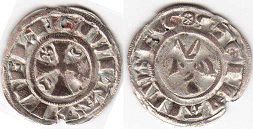
denier no date
silver
MELD CIVITAS
STEPHANVS EPC
Value - 35-45 USD
County of Maine
denier
Herbert I Wakedog (1015-1036)
Herbert (c. 985-1035) son of the previous
Count Hugo III. He got his nickname because of his habit of
getting up early.
The count was a vassal of the Count of Anjou, but constantly
strived for independence. Enmity with the lord led him to
imprisonment in 1025, where he spent 2 years.
Almost the entire time of his reign, Herbert fought with the
bishop of Le Mans (for lands, naturally, since the bishop was
the same lord as the other feudal lords) and was even once
excommunicated from the church.
The minting of coins with Herbert's monogram began in the third
decade of the 11th century. and lasted throughout the 12th
century.
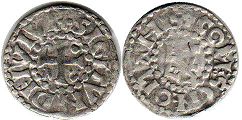
anonymous denier no date (XI-XII c.)
silver
SIGNVM DEI VIVI
COMES CENOMANNI
Value - 30-35 USD
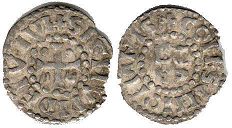
anonymous denier no date (XI-XII c.)
silver
SIGNVM DEI VIVI
COMES CENOMANIS
Value - 30-35 USD
County of Melgueil
denier
Anonymous coinage
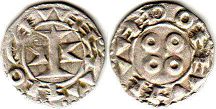
denier no date (11-13 century)
silver
Barbarian legends
Value - 25-30 USD
Signoria of Neufchateau
The town of Neuchateau is located in northwestern France, in Lorraine. In Roman times the city was called Noviomagus (or Noviomagus, Neomagus). In 1094, when the Duke of Lorraine Thierry II (1070-1115) built a castle here, the city appears under the name Novum Castrum. A 12th century poem describes it as large, rich and well fortified. In 1231 Neuchateau became the first settlement in Lorraine to receive city rights. In 1436 and 1476 the city was occupied by Burgundian troops. After the fall of the Duchy of Burgundy, Lorraine came under French control. Richelieu, just in case, ordered the destruction of the city walls. In 1766, the city, along with all of Lorraine, officially became part of France.
denier
Theobald II of Lorraine (1283-1303)

denier no date
silver
NOVOCARTI
Value - 80-100 USD
County of Penthievre
denier
Stephen I count of Tréguier (1093-1138)
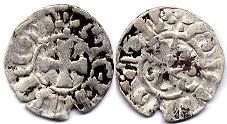
denier no date
silver
STEPIAN COM
GVINGAMP
Value - 25-30 USD
City of Tours
Abbey of Saint Martin
denier
Anonymous coinage
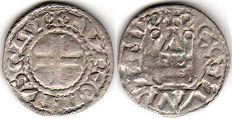
denier tournois no date (XII century)
silver
TVRONVS CIVI
SCS MARTINVS
Value - 25-35 USD
Bourbonnais
Priory of Souvigny
denier
Anonymous coinage
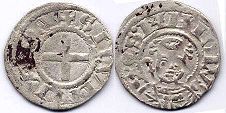
denier no date (XII century)
silver
DE SILVINIACO
SCS MAIOLVS
Value - 50-60 USD
Bishopric of Valence
denier
Anonymous coinage
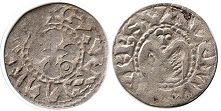
denier no date (XII century)
silver
S APOLLINARS
VRBS VALENTIAI
Value - 15-25 USD
Archbishopric of Vienne
denier
Anonymous coinage
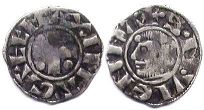
denier no date (12 century)
silver
MAXIMAGALL
S M VIENNA
Value - 15-20 USD
Coins of French Feudalists in the catalog are presented divided by historical periods, indicating the main characteristics and differences by type.
Inside the sections, the coins are sorted by denomination - from large to small.
The cost of the coin is approximate and is indicated specifically for the coin shown in the picture. You can use this price to evaluate similar coins (of the same type), but remember that the value is affected by many factors, such as the state of preservation and the date of minting. The cost of coins of the same type can vary greatly depending on the number of surviving copies.
Coins of French Feudalists presented on this page are not sold or bought - this is only a catalog.
